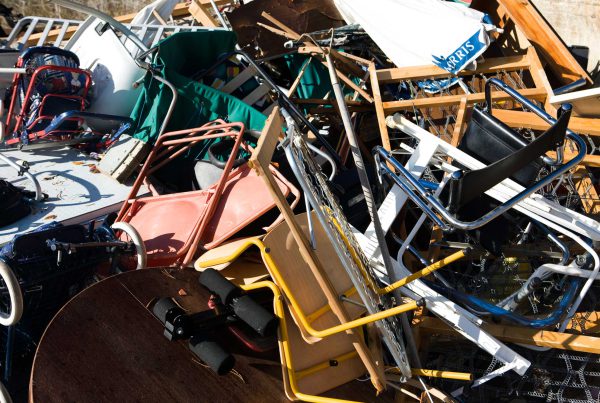Some of us grew up playing Duck Hunt on Nintendo, while others lived in the glory days of the Xbox generation, blasting up The Covenant through the eyes of Master Chief. It’s crazy how much gaming consoles have changed over time; there have literally been dozens of consoles released over the past few decades. We decided to geek out a little and create a timeline of video game console history just because. And hey, who knows – it may just help you out at your next trivia night.
1972 – Magnavox Odyssey
Did you know that console gaming didn’t actually start in the 80’s? It started in the 1960’s with a clunky brown console called the “Brown Box” created by inventor Ralph Baer. This console was later revamped by Magnavox for the commercial market and included plastic overlays for TV screens to make up for its super basic graphics. This early console paved the way for video games as we know them today!
1987 – Atari VCS 2600
Atari changed console gaming forever in 1987 by creating the first popular console capable of accepting game cartridges. Before this, consoles (including Atari’s own Pong) only had self-contained games. The VCS 2600 let players use joysticks or paddle controllers to play several hit games like Pacman, Asteroids, and Frogger.
1979 – Intellivision
In 1979, Mattel Electronics released their own console as a direct competitor to the Atari 2600. The Intellivision (or intelligent television), never surpassed the Atari in popularity, but it did offer competitive audio effects and graphics. Popular games on the Intellivision included golf games, and Las Vegas Poker & Blackjack.
1982 – ColecoVision
Coleco Industries released their competitor to the Atari and Intellivision consoles in 1982. The ColecoVision offered the ability to play games like Nintendo’s Donkey Kong, Sega’s Zaxxon, and some less-popular games like Lady Bug and Cosmic Avenger. The Coleco also offered expansion modules that allowed gamers to play popular games from Atari, racing games, and more.
1985 – Nintendo Entertainment System
The Nintendo Entertainment System (NES) was first introduced in Japan as the “Famicom,” but the console was rebranded as the NES in 1985 and introduced to the U.S. gaming market. Super Mario Bros. launched the console into popularity. The NES was also the birthplace for many other legendary game franchises, including Nintendo’s Zelda, Metroid, and Square’s Final Fantasy.
1989 – Sega Genesis
Japanese-based Sega was one of the top five arcade manufacturers operating in the U.S. until the late 1980’s. As the market changed, Sega shifted away from arcade games and towards the home-gaming console market in Japan. After experimentation and development of other consoles, Sega launched the Mega Drive console in 1988 in Japan. In 1989, it was released in the U.S. as the Sega Genesis. The console trailed behind the Nintendo and NES and Famicom consoles, but still gained popularity through hit games like Sonic the Hedgehog and Mortal Kombat.
1990 – Super Nintendo Entertainment System
In 1990, Nintendo released their next generation of consoles, the Super NES or “Super Nintendo.” This console was actually released under a few different names around the world: in Japan, it was dubbed the Super Famicom, and in South Korea, it was called the Super Comboy. The Super Nintendo boasted upgraded 16-bit graphics over the original NES and even survived as 32-bit games became popular. The Super Nintendo was also the first console to ever include left and right “shoulder” buttons. More than 49 million Super Nintendo consoles were sold worldwide! Some of the most popular games for the console included Super Mario World, The Legend of Zelda: a Link to the Past, and Super Mario Kart.
1993 – Mega Drive II (Genesis)
In 1993, Sega released an updated console. It was sold as the Mega Drive II in Japan and simply “Genesis” in the US. The new console was smaller than the original, lighter weight, offered AV stereo sound output, and had a less expensive mainboard. The console continues to have popularity with Sega-specific games like Streets of Rage, Mortal Kombat and Sonic the Hedgehog.
1995 – PlayStation
In 1995, the Sony PlayStation took the video game market by storm, selling out 100k units in presale and over 7 million by 1996. The CD ROM capabilities of the console allowed games to have 3D graphics and more complex games, leading to popular a surge in new games like Gran Turismo, Metal Gear Solid, and Resident Evil.
1996 – Nintendo 64
The Nintendo 64 was one of the first game consoles to use a 64-bit processor, which gave gamers better graphics than ever before from a Nintendo system. Some hit games on the N64 included Goldeneye 007, Donkey Kong 64, Star Fox 64, and Super Mario 64.
2000 – PlayStation 2
In 2000, Sony upped their game yet again with the PlayStation 2. The new console featured DVD playback abilities, which was a huge selling point at the time. It also offered backward compatibility, so gamers could still play their PS1 games. Some of the top games for this console included the Grand Theft Auto franchise, Shadow of the Colossus, and Kingdom Hearts.
2001 – Xbox
In 2001, Microsoft hopping into the console realm and kicked off what’s known as the “console wars.” To compete with PlayStation, they introduced the Xbox Live service that let players compete online. The Halo franchise really kicked Xbox into gear when Halo: Combat Evolved and Halo 2 launched into popularity.
2005 – Xbox 360
In continuation of the console wars, Microsoft threw another jab at Sony with the Xbox 360 in 2005. It featured improved graphics, wireless controllers, and third-party streaming capabilities. Popular games included Call of Duty, Halo, and Gears of War.
2006 – Nintendo Wii
In the heat of the console war between Sony and Xbox, Nintendo released a family-friendly alternative. The Wii offered the ability to use motion to play games rather than simple buttons and joysticks. Players could bowl, play golf, and even duel with light sabers using a first-of-its-kind remote that helped get kids off the couch with active gameplay.
2006 – PlayStation 3
Sony released the PS3 as a competitor to the Xbox 360 in 2006. To compete with Xbox live, they introduced the PlayStation Network as a free alternative to Xbox live. Some popular games on the console included Assassin’s Creed Rogue, Far Cry 4, Red Dead Redemption and more.
2013 – Xbox One
Microsoft Xbox released their current generation of consoles in 2013 — the Xbox One. Like the Xbox 360, it continued to offer Xbox Live and third-party streaming. The new console boasted improved graphics, a sleek design, and support for a huge number of games. Some popular early Xbox One games included Call of Duty Black Ops III, Minecraft, and Fallout 4.
2013 – PlayStation 4
Sony’s current generation of PlayStation, the PS4, is the most advanced yet — introduced on the tail end of the Xbox One release. It has sharp graphics, VR capabilities, and an impressive library of games to choose from. The PS4 competes with the Nintendo Switch and Xbox One for popularity in 2018. Popular games for the console are Fortnite, Black Ops IV, and Destiny 2.
2016 – Xbox One S
In 2016, Microsoft gave the Xbox One some major upgrades with the new Xbox One S. The updated console was smaller, could upscale games from 1080p to 4K, and stream 4K video.
2016 – PlayStation 4 Pro
In 2016, Sony upgraded the PS4 to compete with 4K upscaling offered by the Xbox One S. The new PlayStation 4 Pro was smaller, sleeker, and could also handle 4K upscaling. Win, win, win.
2017 – Xbox One X
The current generation of Xbox was released in 2017, and offers even more graphics upgrades over the Xbox One S and PlayStation 4 Pro. The new Xbox One X supports 4k video and gameplay natively. It also boasts 40% more processing power than any other console on the market. Some current popular games for the Xbox One X include Fallout 76, NBA 2K19, Call of Duty: Black Ops 4, and Assassin’s Creed Odyssey.
2017 – Nintendo Switch
Nintendo changed the game in 2017 by offering a console that could do more. The new Nintendo Switch works as both a handheld console and a TV-based console, and the clip-in controllers give gamers a huge amount of flexibility. So far, the most popular games on the Switch are Legend of Zelda: Breath of the Wild and Super Mario Odyssey.
2020 – PlayStation 5
Released in November 2020, a full four years after its predecessor, PlayStation 5 helped introduce the ninth generation of video game consoles with two models: the PS5 with 4K Blu-ray drive for gamers who enjoy digital downloads, retail game support, and playback to their TVs and the Digital Edition model for gamers who rely solely on digital downloads. The console’s Tempest 3D AudioTech affords it the capability to play hundreds of sound sources simultaneously while PS4 played only 50. Its DualSense wireless controllers feature immersive haptic feedback, adaptive triggers, and a built-in microphone. Higher refresh rates make game play feel smoother and a custom SSD gives PlayStation 5 the potential for the fastest game load times of any console on the market.
Feeling inspired to start gaming? Aaron’s offers rent to own gaming consoles (including some TV bundles).






















